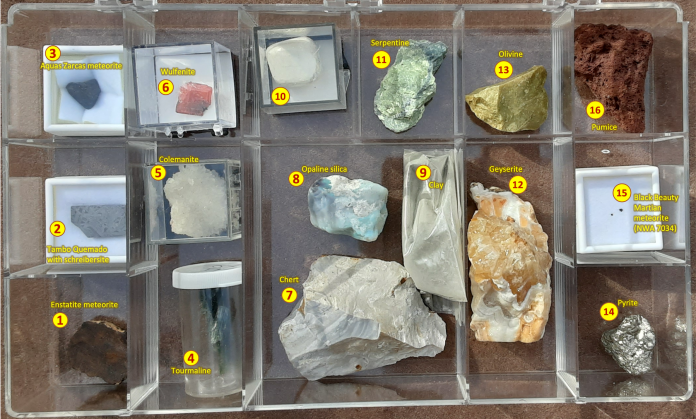Below is the latest version of my exhibit which has been shown at 22 international conferences since 2014. From left to right and top to bottom I will identify each meteorite or mineral and its role in the Origin of Life four billion years ago. This is based on the latest research through January 2021.
- The brown specimen is an enstatite meteorite which could have supplied all of Earth’s water (Piani)
- The silver specimen is the Tambo Quemado meteorite which contains schreibersite (phosphorus) Pasek
- The black specimen is the Aquas Zarcas meteorite which contains organic molecules (Glavin)
- The green specimen is tourmaline from Benner’s life originated on Mars theory (2013)
- The white specimen is colemanite from Benner’s life originated on Mars theory (2013)
- The red specimen is wulfenite from Benner’s life originated on Mars theory (2013)
- The large white specimen is chert from Westall’s silica gel theory (2017)
- The blue specimen is opaline silica from Deamer’s wet-dry cycles pool theory (2016)
- The plastic packet contains clay from Cairns-Smith and Ferris clay scaffold) theories (1970’s)
- The white specimen is magnesite from Horgan’s study of Jezero Crater on Mars (notOOL)
- The green specimen is serpentine from Russell’s white smoker theory (2000’s)
- The brown and white specimen is geyserite from Campbell’s hot springs theory (2016)
- The green specimen is olivine from Russell’s white smoker theory (2000’s)
- The gold specimen is iron pyrite from Wachtershauser’s black smoker theory (1988)
- The tiny black specimen is the Black Beauty (NWA 7034) meteorite containing CHNOPS and parts of Mars surface from four billion years ago Agee (2012)
- The red specimen is pumice from Brasier’s pumice raft theory (2011)
This exhibit is 16 specimens, reduced from the 23 at the Perseverance website. The five specimens which should be near biosignatures on Mars are chert, serpentine, clay, opaline silica, and magnesite.
Bob Bruner, Denver Museum of Nature and Science, Denver, Colorado 80205, USA



